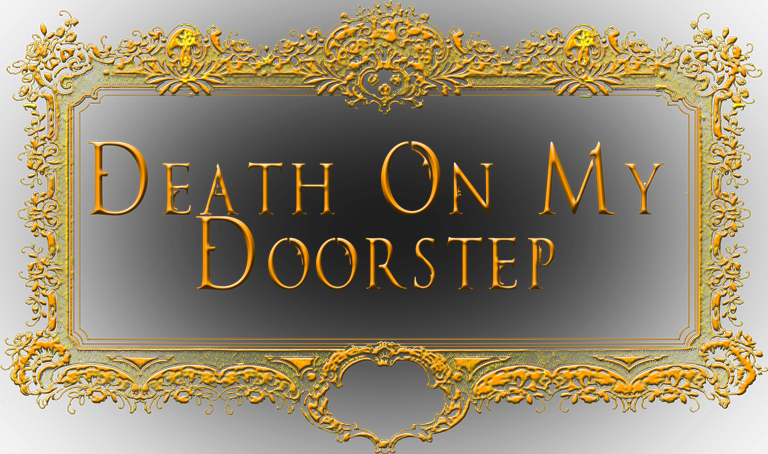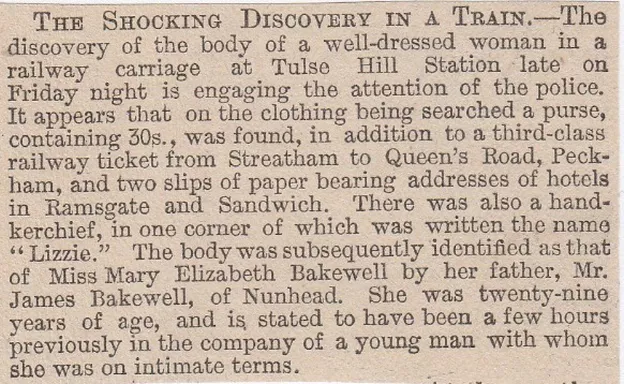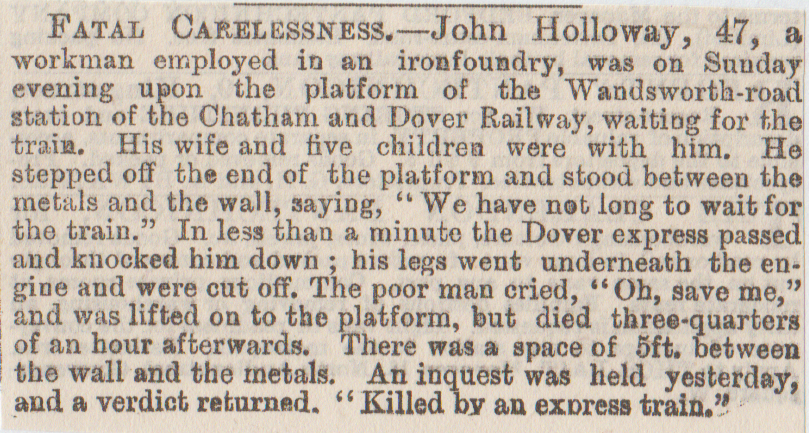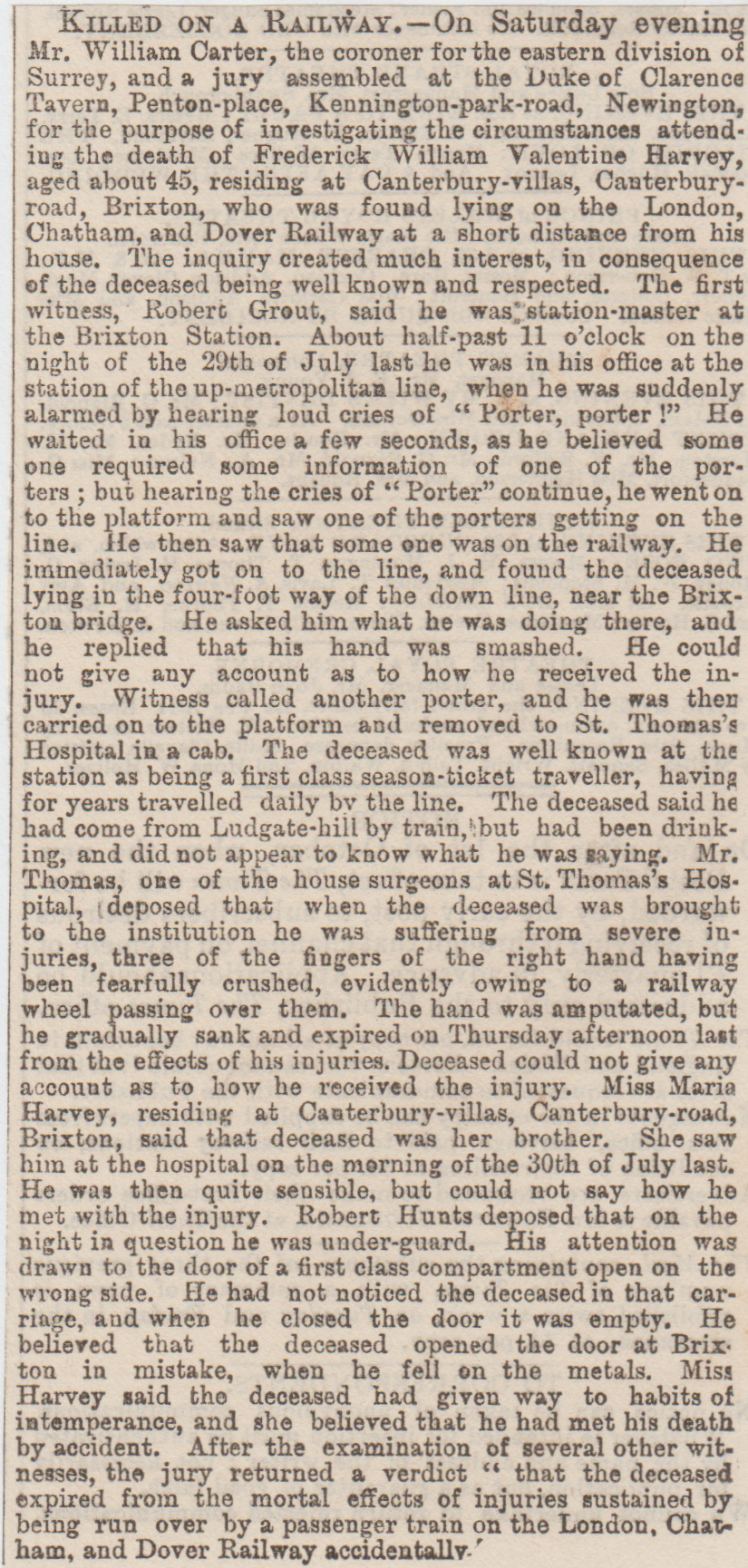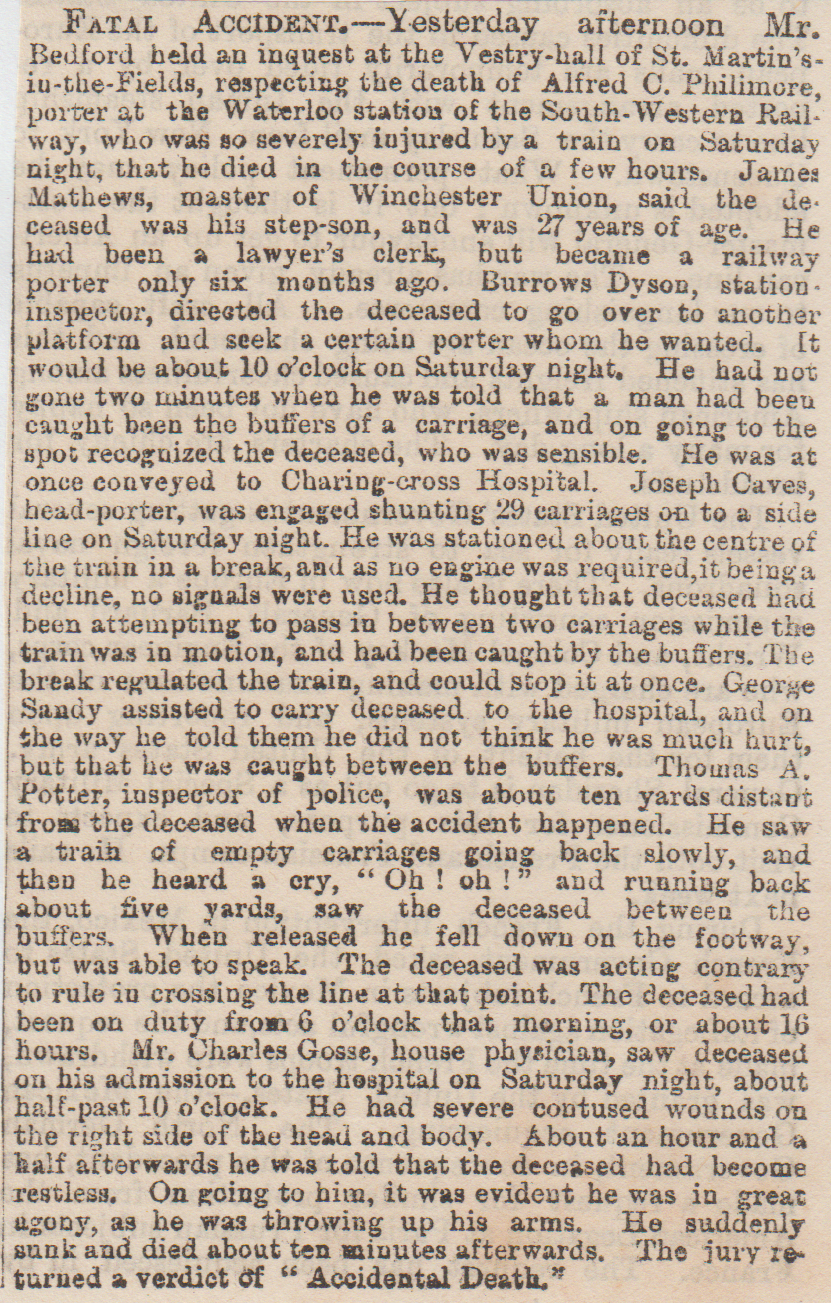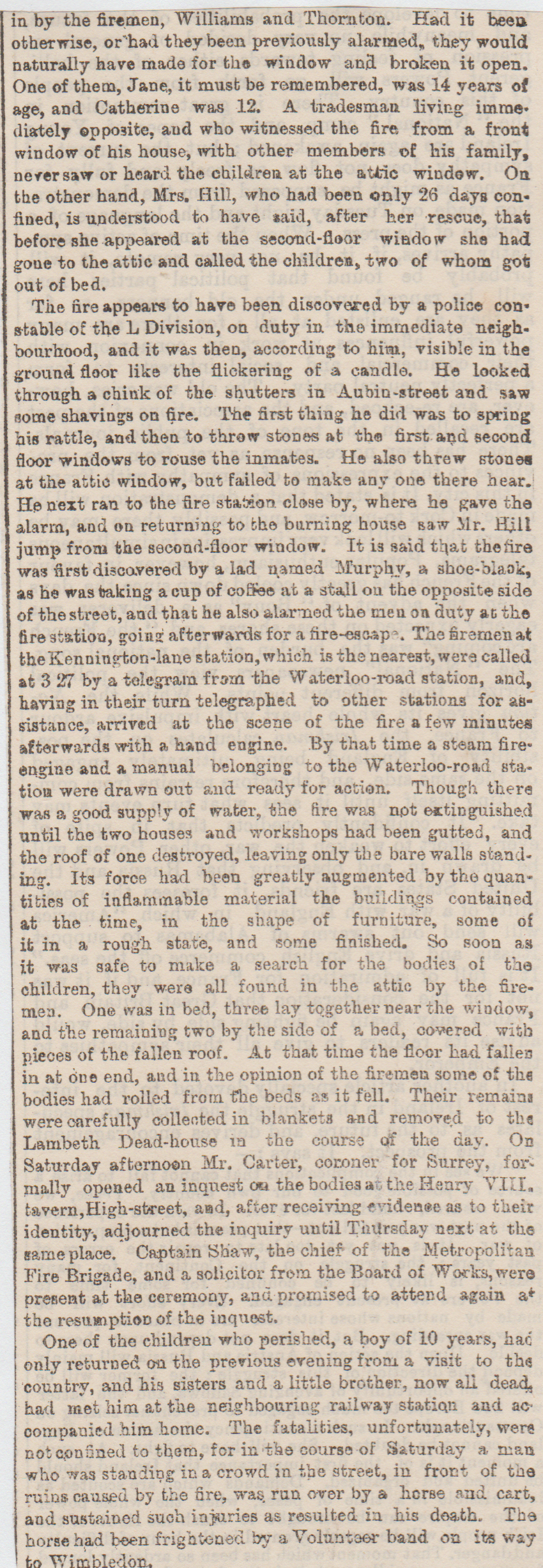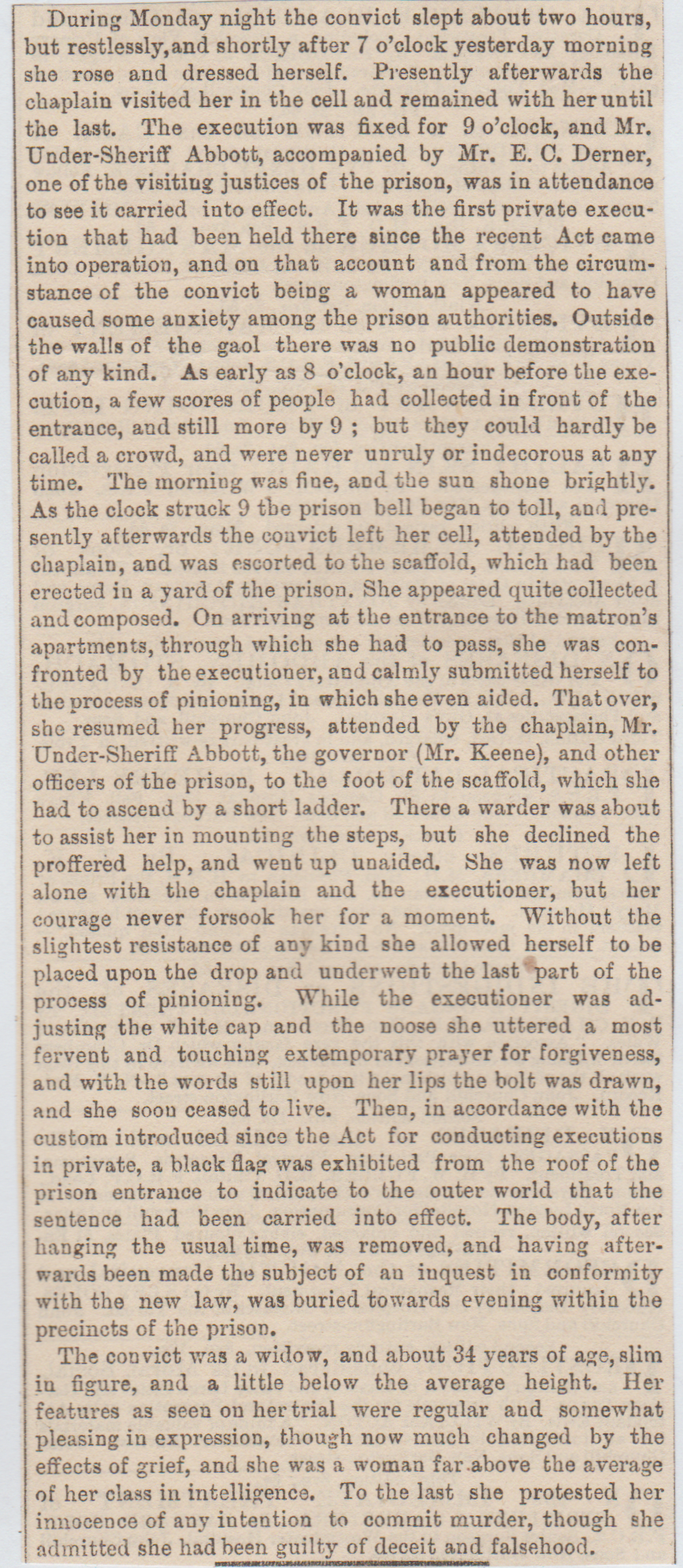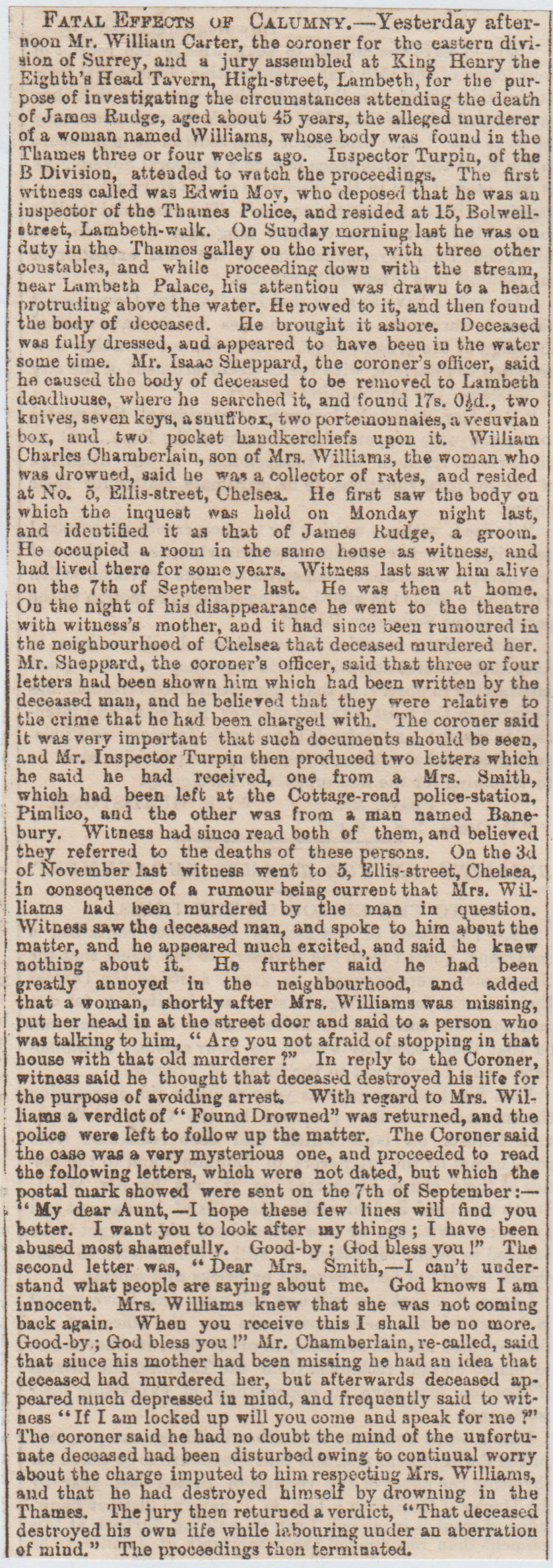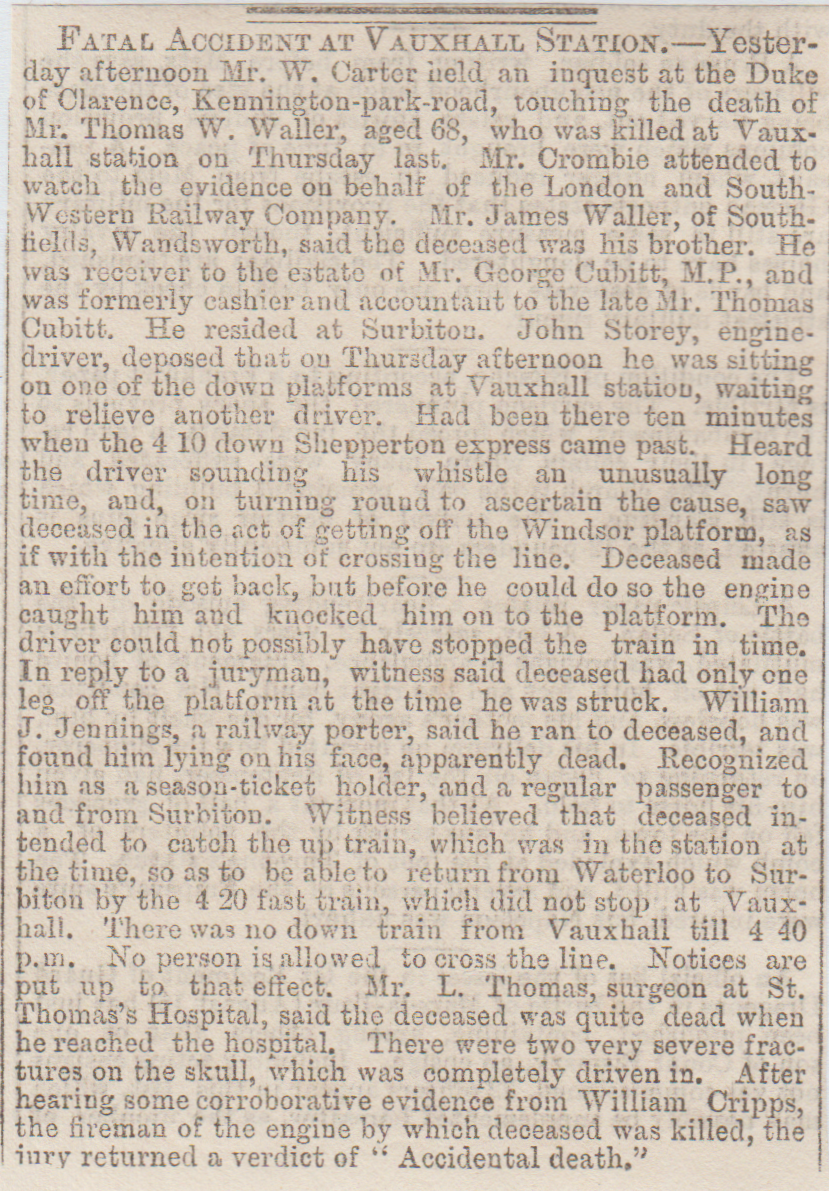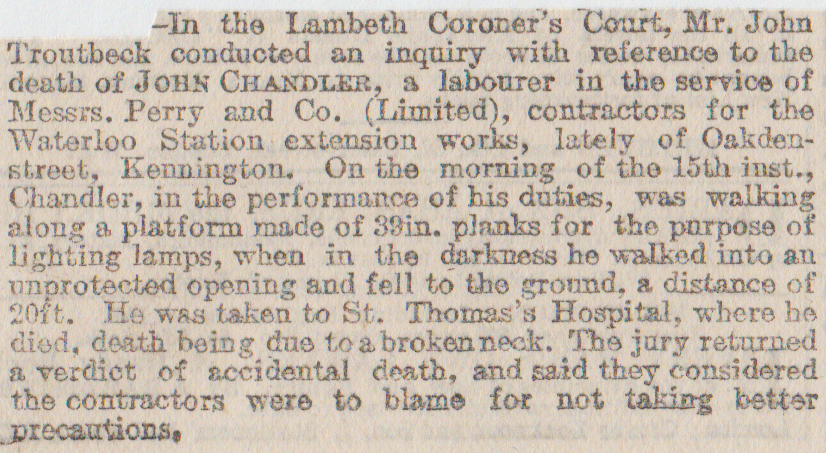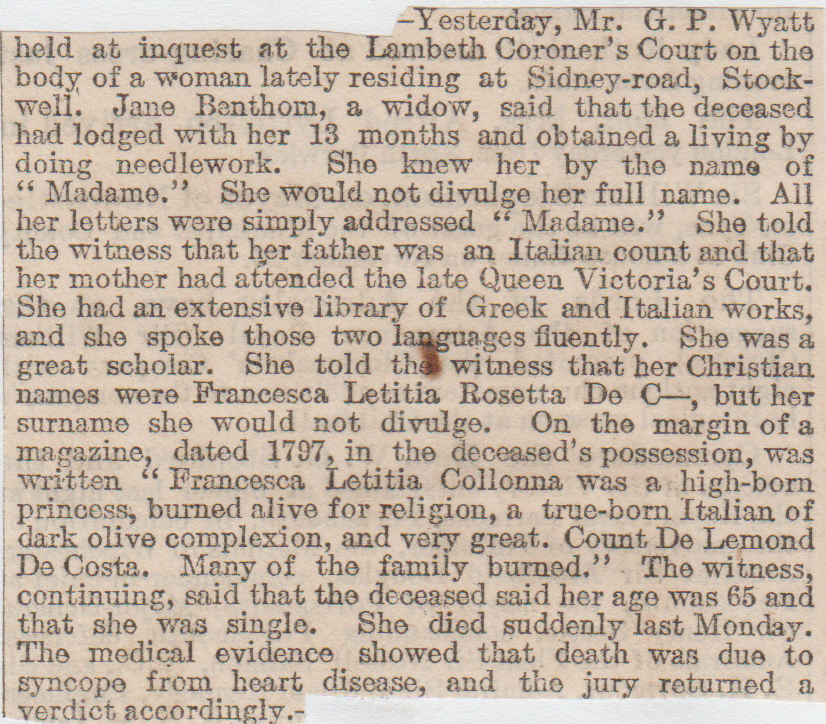1/ Stockwell Murder, Lambeth, October 1871

2/ Lambeth Palace Suicide, January 1881
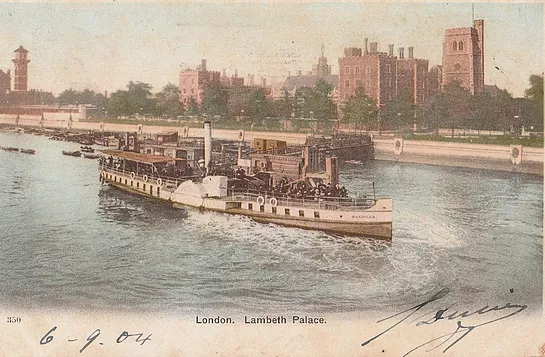
The Archbishop of Canterbury’s town residence, Lambeth Palace (above) had a bit of a buzz about it in 1881, when in one of the tower’s there was the suicide of a man who cut his throat and nearly severed his head off in the process.
Mr and Mrs James Somsons had been in the Archbishop’s employ for quite some time, with Mr.Somsons acting as the palace-keeper. They both went to bed together, but the next morning she went to wake up hubby and he was missing. The gardener, Anning, helped in a search and upstairs he noticed some blood, a large amount. He went into the room and found deceased lying on the floor with a huge gash across his throat and a knife lying nearby. He was part-dressed and the window was open, this was thought to be because he was going to throw himself out as well. Somsons must have passed out due to blood loss otherwise he would have achieved his goal.
3/ St Annes Asylum, Streatham May 1895
A female patient at St Annes Asylum in Streatham, has committed suicide by jamming a red-hot poker down her throat.
4/ Waterloo Station, (Dead Infant Left) January 1884
C.I.D. officers are making inquiries into the murder which has just been brought to their notice. A train arriving at Waterloo from Richmond New Station was checked over by an attendant and when in the first-class carriages, he discovered a package wrapped in grey paper. The inevitable dead infant was found wrapped in white calico. A post-mortem examination revealed that the baby boy had strangulation marks around his neck, and as yet it has not been identified or no clue as to the parents was left behind.
5/ Surrey Gardens Tragedy, October 1856 (Near The Oval and Kennington Park Road)
This is a quick summing up of the disaster at Surrey Gardens. It was the largest music hall in London and there were thousands crammed in to see a preacher called Spurgeon do his religious routine. He read from a scripture then said a prayer and then sang a hymn, and when he was about to say “Amen” someone screamed out “Fire Fire, the place is falling”. Then mass hysteria ensued and panic as people trod on each other, climbing over railings and stairs giving way because of the huge numbers using them all at once. Spurgeon himself tried to calm things but the end result was eight dead and over fifty injured.
6/ Cornwall Road Manslaughters, Lambeth, April 1899
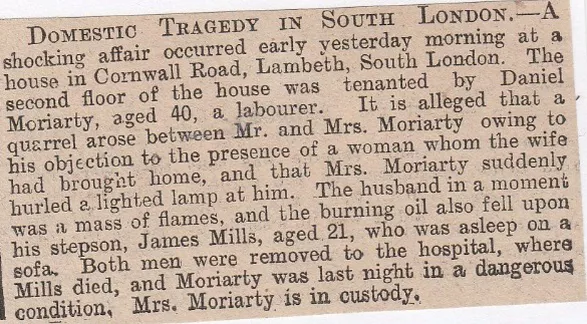
7/ Canterbury Theatre of Varieties Murder/Suicide, June 1889
The Canterbury Theatre of Varieties in Westminster Bridge Road was the scene of the murder of George Letine, a music-hall artist and the attempted suicide of Nathaniel Curragh. Letine was actually an acrobat, part of the Letine Troupe and they had just been on stage at the Paragon Music Hall, and then just rolled up outside the Canterbury. The ladies of the troupe got out the carriage and went to get changed quickly and Mr Letine was left alone nearby, when a man came out of the shadows of the stage door and said “I have been waiting for you a long time, and now I’ve got you”, then stabbed him in the stomach. He then calmly walked over to the other side of the street and put a gun in his mouth and fired. Letine was rushed to hospital but expired soon after. Curragh was said to be in no immediate danger and looks as though he will pull through.
8/ Canterbury Theatre of Varieties Murder, July 6th, 1889
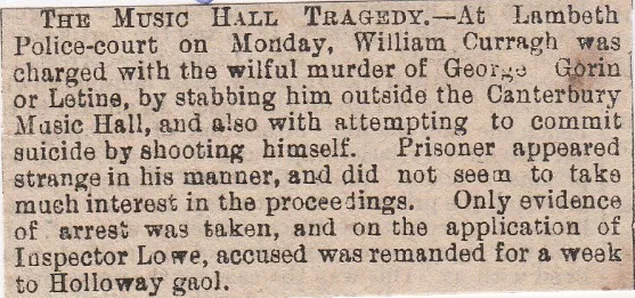
9/ Victoria Theatre Tragedy, (The Old Vic) December 1858
Mass panic caused the deaths of fifteen people at London’s Victoria Theatre. The deceased are young lads aged between fourteen and twenty-one, no women died. A pantomime was on stage and a gas leak exploded, then someone shouted “Fire!”, then people scramble to get to the exits and the youngsters were trampled upon by the hoards. (In the end, sixteen people were killed)
10/ Stockwell Tube Station Suicide, January 1918
This one is particularly sad, as you’ll see at the end. It is the suicide of Herbert Ernest Pindler aged forty-four, who had been for three years been working seventeen-hour days in a munitions factory due to the First World War. In April of 1917, he had a breakdown, became delusional then attempted suicide by slitting his throat. In time he recovered and went to work at an opticians. His father had arranged to meet him at Stockwell Tube Station. While he was waiting on the platform he saw his son dive in front of the tube train. The body was terribly cut and mangled and he died there and then.
11/ Victoria Road Murder/Suicide, Clapham Common, March 1900
James Roberts, a forty-five-year-old unemployed gardener was that tired of life and the struggle to make ends meet, that he hung his 14-year-old imbecile daughter, Jeanette, from a beam and then killed himself in the same way, on the same beam. He had been out of work for some time and his wife left them both and this when he decided to end it all. They were living above a stable in Victoria Road and the whole situation had become far too much for Roberts to bear.
12/ Lambeth Christmas Deaths, January 1890
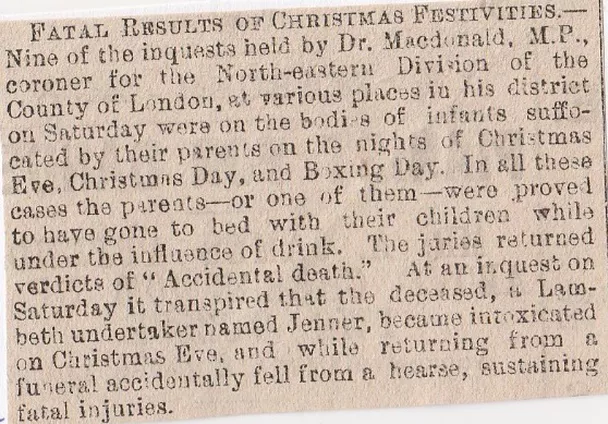
13/ Chester Street, Lower Kennington Lane, Lambeth, August 1880
This one is still there but now is Chester Way. This suicide took place at No.43, Chester Street and the victim, Mr Dixon did it by hanging. He was cut down but was already dead. The reason for his self-destruction was a common excuse in Victorian times, and that was having no work to pay the bills and to put food on the table.
14/ South London Music Hall Suicide, November 1906
This is a gruesome discovery when you turn up to work one morning and find the night-fireman hanging from the bars of the gallery. This happened at the South London Music Hall on London Road. The victim was Samuel Harmer, and as he was cut down it was obvious that he was already dead. When at work last night, the twenty-five-year-old was in a good mood and he had just been with his fiancee to the performance. He had only been there three months but was a reliable and steady worker and no reason for this rash act. His fiancee was totally beside herself when she heard the news.
15/ Brixton, May 1900 (Stabbed Twenty-seven times)
Nowadays, police and forensics would class this as personal killing due to the number of stab wounds dished out to the victim. Mrs Wakenell was forty-two and had been stabbed twenty-seven times with a pair of scissors, which were left sticking out of her chest. The deceased and her husband were separated and she only rented a couple of rooms, in which she lived with her sixteen-year-old son who had discovered her body. Nothing unusual was seen or heard, but the victim was seen in the street after midnight on Friday. Why out so late?
16/ Lambeth Tragedy, July 1889
At Lambeth police-court on Saturday, James Crickmer, a pawnbrokers’ salesman, was charged on remand with the wilful murder of James Howard by stabbing him and with attempting to murder Margaret Webb. On application from the Treasury, the prisoner was further remanded. The woman Webb was brought to court afterwards and pointed out the prisoner as her assailant.
17/ Edward Street, York Road, Lambeth, April 1892

18/ Clapham, February 1845 (Infanticide/Suicide)
Eliza Daniels gave birth to an illegitimate child in her bedroom. Then she suffocated the newly born and grabbed a razor and then slit her own throat. Her mistress heard a commotion upstairs and there she found the dead baby and Daniels was bleeding from three large gashes. Medical assistance was procured but it was just too late, and she expired soon after.
19/ Lyam Road Pram Fatality, Brixton, September 1885
A little child named Blogg was wheeling a baby in a perambulator in Lyam Road, Brixton, on Tuesday, when by some means it was overturned. Before the infant could be picked up, the wheel of a contractor’s cart had passed over its head and it expired within an hour after the occurrence.
20/ Waterloo Station Child Murder, June 1883
The Metropolitan Police force are trying to trace the people implicated in the murder of a female child, found in a railway carriage at Waterloo Station with its throat cut from ear to ear. Passengers had just got off the train, and the porters were going through the carriages when one found a large bundle. It was unwrapped and had some pieces of calico and brown paper crudely wrapping the remains of the girl.
21/ Waterloo Station, August 1885 (Death by Plum)
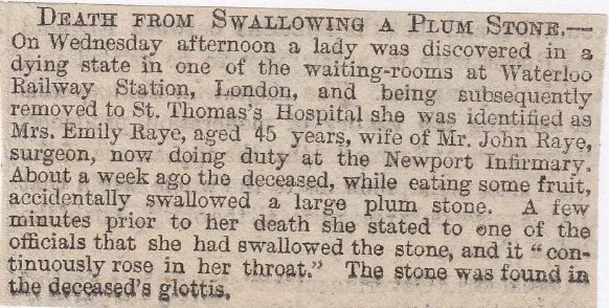
22/ Streatham Station Suicide, September 1897
A terribly mutilated body of a young lady has been discovered on the railway line near Streatham Station. Later on, she was identified as the daughter of the landlord of the Duke of Edinburgh public-house in Wimbledon. It is clearly a suicide.
23/ Newington Place, Kennington, November 1840 (Suicide in Water-butt)
Sixty-one-year-old John Bowler of 38, Newington Place, had been ill for some time and the gardener was asked to sleep in the same room as him in order to keep an eye on him. One night a partner of his, Mr Jarratt, popped in to see him but he was nowhere to be found. The gardener looked around the grounds for him and saw his hat next to water butt. The feet of Bowler were protruding from the top and his head was underwater. He was dead but seemed to have been there quite a while.
24/ Surrey Theatre Fatal Accident, October 1858
It was a Monday night and the crowds were gathering outside, ready to be let into that evening’s performance. The doors opened and in they rushed, but one gentleman who had gleaned a front row seat, over-balanced and plummeted into the pit. He landed head first on a wooden seat and split it in two. He was concussed and taken to St Thomas’s Hospital but died the next morning. He is yet to be identified but wore a black hat, cords, and was about forty years of age. (Who was he?)
25/ Linom Road, Clapham, November 1896
Mrs Brown, alleged to have been savagely assaulted by her husband who was a commercial traveller, with a hammer on Monday week at their residence,14, Linom Road in Clapham, died late on Saturday night in St Thomas’s Hospital. Brown, who is suffering from several self-inflicted wounds, is progressing favourably.
26/ Atlantic Hotel, Brixton, October 1897 (Is it still there?)
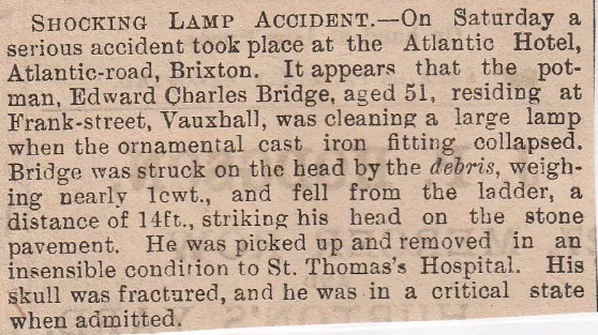
27/ Philadelphia Terrace Skeleton, Lambeth, September 1895
An awful discovery was made when some workmen were demolishing some house down Philadelphia Terrace, which lies of Westminster Bridge Road. Hidden betwixt the floor and ceiling were the skeletal remains of a child. It wasn’t mummified or badly decomposed, so it must have occurred recently, but rats had stripped it of its flesh. It seems to have been murdered as there were indentations in its little skull and police are looking into the matter. (Who did this?)
28/ Vauxhall Station Suicide, August 1873
The body of a man was found in the toilets at Vauxhall Station, with his throat cut from ear to ear. At 11-30, the night-watchman was making sure everything was OK when he tried one of the doors at the W.C.’s. It was locked and getting no reply, he forced it open. Inside was a fair-haired chap, about thirty-five, five feet six inches tall with a brown jacket and black trousers on. He had a penknife, a pencil and a handkerchief on him and when the body was moved it was stone cold. He had been there at least three hours. Did the bloke poison himself? Was it a heart-attack?
29/ Surrey Theatre Fatality, September 1846 (Lad Trampled to Death)
One evening, just as the audience was leaving the building, a young lad of thirteen named John Morris, got caught up in the melee and was knocked down on the gallery staircase and before he could be lifted out he was literally squashed to death by the crowd. Not unusually in Victorian times, he was picked up and conveyed to his lodgings in Pitt Street, St George’s Road in Southwark.
(Surrey Theatre stood in Blackfriars Road, near the junction with Westminster Bridge Road in Lambeth, which was then the entertainment district of London.)
30/ Waterloo Road Railway Station, November 1849 (Suicide through Brotherly Love)
The suicide of Dr J.Allen, R.N. took place on a platform at Waterloo Road Railway Station, just as a train was setting off. He jumped under the engine and was crushed to smithereens. His brother had died recently and he became depressed and dejected. He had served in China, in his Royal Navy capacity and South America too and had just been given the job on the transport ship “Bangalore”. He and his brother were very close and although only thirty-four-years-old, he wanted to join him.
31/ Tulse Hill Railway Station Mystery, February 6th, 1899

32/ Tulse Hill Railway Station Mystery, February 8th, 1899
33/ Lambeth Double Suicide, August 1917
An inquest was held on the deaths of Nora Mahoney and Rose Boore, who were found in bed, dead from gas poisoning, with their arms around each other’s neck. The history of the two women is that Mahoney was engaged to a sailor, got a mouthful from her mother about her friendship with a Frenchman named Menecus, so she left to go and live with Boore. Boore told a waiter where she worked “I am going to die”. A letter was left behind, signed by the both of them and it was short and sweet.
“To my dear boy,-Maggie wished us bad luck, and it has come true. After this, she can make no more mischief. Goodbye”
The “Maggie” mentioned in the letter, was a maid at the restaurant where they both worked.
34/ Clapham Junction Suicide, October 1900
Ernest Cooney was a sixteen-year-old in the 3rd Volunteer Battalion Royal Fusiliers and was discovered in a railway carriage near Clapham Junction with a bullet hole in him. His mother said everything had been all right up until he went to camp at Pirbright. It was here he learned to play cards and had been gambling his money away at an alarming rate. He had lost £18 in two months, which for someone who earned twelve shillings a week as a tobacconists packer, was a huge amount to fritter away.
35/ Paradise Street, Lambeth, February 1887 (Haunted House Discovery)
Several workmen were digging up the backyard of number 36, Paradise Street, in Lambeth, preparing for the widening of the South Western Railway, they found some bones and four skulls about three feet below the surface. A police surgeon confirmed they were human remains and had been underground for numerous years. The present owner was told that the area was once a market garden and that when she moved in several years ago, the neighbours told her she wouldn’t be there long as the place was haunted, with murders having been committed there. (Who were the skeletons?/Was it haunted?)
36/ St Thomas’s Hospital Murder, July 1889
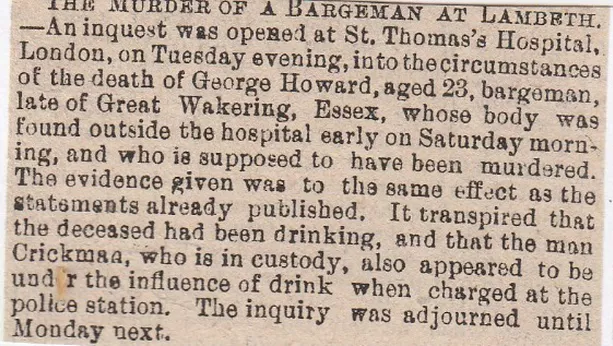
37/ Dows Street Fatal Fire, Lambeth, April 1885
38/ Vauxhall Station Suicide, October 1887
Thomas Edward Turner aged twenty-six threw himself under the passing train at Vauxhall Station and died at St Thomas’s Hospital from the injuries he sustained. The reason for the act of self-destruction was quite a melancholy tale in itself. A railway guard by the name of James Peace spotted him laying down on the tracks as he was leaving Vauxhall, so he put the brakes on the train then gave an alarm and then carried on. A suicide letter was found on the remains, and it said:
“Miss Georgie Francis, c/o R.Warner, York Road, Lambeth- My own darling wife. I received your cruel letter. By the time you get this, I shall be dead. I can only ask you, as I am now out of the way, for God’s sake and for the love you may still have for me, to give up that cursed dog, Paris. You will be able to earn sufficient to keep yourself without me. I cannot live. May God bless you.
I am going to throw myself under the 9-24 at Waterloo. All I can say is, God, bless you. My heartiest curses on the persons at 65, Stratford Road, Birmingham. God bless you, from your husband Tom”
Neighbours said that the deceased’s wife was an actress and the pair had lived in Birmingham before moving here, but that she had run off with another bloke and poor Turner ended up in lodgings off the Lambeth Road. The landlady of his lodgings stated that Turner hadn’t eaten or slept properly for a week and was upset at not meeting the fellow who had run off with his missus.
39/ Gresham Arms Hotel, Brixton, September 1900 (Haunted Hotel)
Supernatural occurrences are causing management and staff at the Gresham Arms Hotel in Brixton to hand in their notices as they cannot put up with the ghostly goings-on. The bells in the hotel ring all at once, plus other bangings and battering of large objects, coming from the cellar. Doors that were locked on the night-time are wide open in the morning and gas jets seem to light themselves, as if by an unknown hand. The snooker balls are locked in a drawer at night and the following morning they are strewn all over the table as if they have had a frame or two in the night. A barmaid left the premises and her job when she woke one evening and saw her bedroom door slowly opening by itself. The manageress has also left her position. A barman who works there, an ex-soldier from South African duty, has tried to do a Scooby-Doo and the gang, by solving the puzzle himself. He is not sure, but rats or mice could be ringing the bells at night-time.
A group of spiritualists were dragged in to investigate and when they entered the hotel, the bells, whose wires had now been cut, started ringing ferociously. A medium contacted a spirit who was said to have died in the hotel several years ago. After this door began opening and shutting by itself and then a poker was thrown down the stairs.
***The Gresham Arms- just north of Gresham Road, off Wiltshire Road. As of 2016 it was disused and used to be The Gresham pub in Fyfield Road, Brixton-SW9 7HT.***
40/ Lambeth Poisoner, (Neill Cream) August 1892
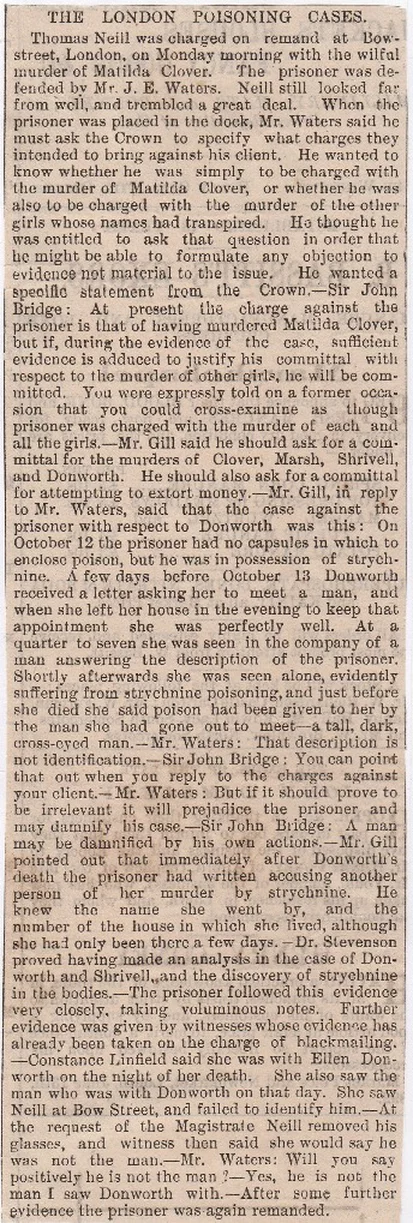
41/ Stockwell Park Crescent Suicide, October 1892 (Strange Story!)
Either this guy is a man of saintly proportions for what he did for this lady, or as gullible as s**t. Edith Ricketts was the assumed name of this lass, while she lived with Mr William Simon Percival Ricketts, a surgeon-captain in the Indian Medical Service. She was found in the apartment suffering from the effects of carbolic acid or chlorodone poisoning and lived for another 24 hours, but then passed away. This is Mr Ricketts’s story- He knew her as Edith McBean or Hamilton. That should set the alarm bells ringing when she’s got two different names! She said her father was a doctor in Sydenham and told him she was twenty-two-years-old. The first time they met was in Brighton on June 6th and she gave him some hard-luck story about how she couldn’t get work and how hungry she was. He bought her some dinner and then she suggested that she could accompany him back to London and he could help her get a job. He agreed. While she stayed in Stockwell, he was in Kent for a month or so, and when he got back she begged him that they could live together. Again, he agreed! She was passed off as his wife, so adopted the name, Mrs Ricketts. He had to go away again, this time to Bedford and while away he received four letters from her and he sent £5 to help her out. This was in September and now he came back to a dead body. (Who the hell was she?/ Was he all there?)
Yeah, of course, I’ll buy your food/Yeah, of course, you can move in with me/Yeah, of course, you can pretend to be my wife/Yeah, of course, I’ll send you money? Is he thick?
42/ Cornwall Road, Waterloo Road, December 1883 (Bridegrooms Suicide)
The arrangements had been made for a Christmas Day wedding for 25-year-old John Denton. On the day, his mother and younger brother went down to the church to watch him walk down the aisle with his new wife-to-be. The bride was waiting there at eleven o’clock, along with her parents and other relatives, but when it got to twelve o’clock, they got nervous. The mother and brother went to find him. Meanwhile, at number 37, Cornwall Road, where Denton lodged, the landlord heard a massive thud and went up to find Denton laid on the floor with a dark liquid oozing from his mouth. A bottle next to him was labelled carbolic acid. The young groom was whisked off to St Thomas’s Hospital but died a few hours later.
43/ Stockwell, October 3rd, 1885 (Double Child Murder)
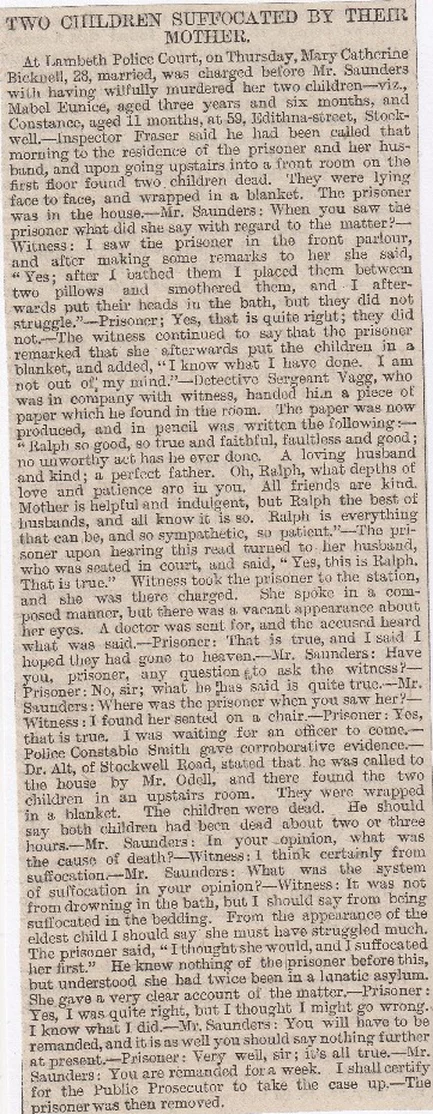
Stockwell, October 6th, 1885 (Double Child Murder)
Yesterday morning Mr William Carter, coroner, opened an inquiry at Clapham touching the deaths of Mabel Eunice Mary Bicknell aged three and a half years and Eva Constance Bicknell aged eleven months, the daughters of a warehouse keeper living at Edithna Street, Landor Road, who it was alleged had been murdered by their mother, Mary Catherine Bicknell, who is under remand by her own confession. The jury returned a verdict of wilful murder against the mother.
44/ Stockwell, October 9th, 1885 (Double Child Murder)
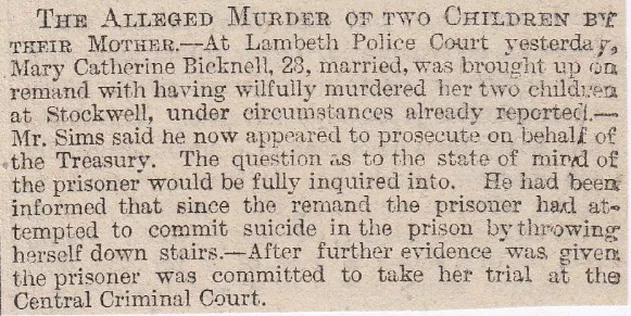
45/ Lark Hall Lane Murder, Clapham, January 1885
Horace Robert Jay, a Clapham barman, was executed within Wandsworth prison yesterday morning for the murder of a girl named Florence Ellen Kemp in a fit of jealousy. Lark Hall Lane was where the murder took place.
46/ Canterbury Music Hall Gymnast Murder, (143, Westminster Bridge Road) July 1889 (Bombed in 1942)
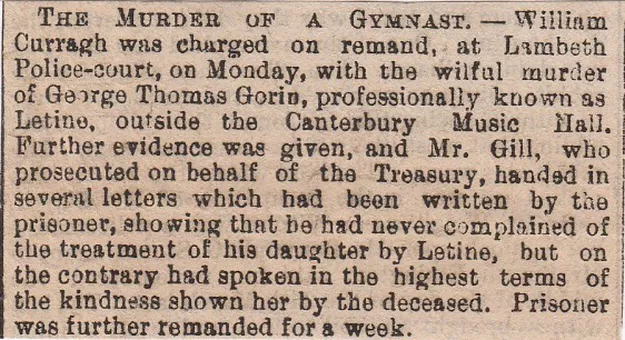
47/ Wandsworth Rd Station Fatality, September 1870.
48/ Brixton Station (Railway Fatality) August 1870.
49/ Waterloo Station (Fatal Accident) August 1870.
50/ Waterloo Road Fatal Fire (Six Children Killed) 132/134 Waterloo Road, forming the corner of Aubin St; L.C.C Fire Brigade Station still there!
51/ Brixton Baby Farming, (Waters and Ellis) July 1870.
Wednesday, October 12th, Execution of Margaret Waters, Horsemonger Lane Gaol. (The Gaol is where Newington Causeway is today, in Southwark, but the crimes were committed in Lambeth)
52/ Suicide Due to Slander (Body found near Lambeth Palace) December 1870
53/ Omnibus Fatality near Kings College Hospital, November 1870
Last evening Mr Bedford held an inquest at King’s College Hospital touching the death of Mr Henry House, aged thirty-four, a man cook. Mrs Elizabeth Lee stated that she was standing on her doorstep on Saturday night last, when she observed the deceased coming across the road towards her, and just as he reached the curbstone, he slipped back and fell into the road. At that moment an omnibus, driven by Thomas Brown, in the employ of the General Omnibus Company, came by, and the wheels passed over the poor man, smashing his breastbone and fracturing several of his ribs. He was carried to King’s College Hospital, but gradually sank, and died on Monday evening. Accidental Death was the jury’s verdict, and they exonerated the driver of the omnibus of all blame.
